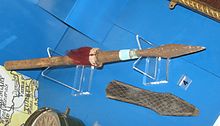Qiang (spear)
| Qiang | |||||||||||||
|---|---|---|---|---|---|---|---|---|---|---|---|---|---|
 | |||||||||||||
| Chinese name | |||||||||||||
| Traditional Chinese | 槍 | ||||||||||||
| Simplified Chinese | 枪 | ||||||||||||
| |||||||||||||
| Korean name | |||||||||||||
| Hangul | 창 | ||||||||||||
| Hanja | 槍 | ||||||||||||
| |||||||||||||
| Japanese name | |||||||||||||
| Kanji | 槍 | ||||||||||||
| Kana | やり | ||||||||||||
| |||||||||||||
Qiang (pronunciation: [tɕʰjáŋ], English approximation: /tʃjɑːŋ/ chyahng, simplified Chinese: 枪; traditional Chinese: 槍; pinyin: qiāng; Jyutping: coeng1) is the Chinese term for spear.[1] Due to its relative ease of manufacture, the spear in many variations was ubiquitous on the pre-modern Chinese battlefield. It is known as one of the four major weapons, along with the gun (staff), dao (sabre), and the jian (straight sword), called in this group "The King of Weapons".[2]

Common features of the Chinese spear are the leaf-shaped blade and red horse-hair tassel lashed just below. The tassel shows elite troop status. It also serves a tactical purpose. When the spear is moving quickly, the addition of the tassel aids in blurring the vision of the opponent so that it is more difficult for them to grab the shaft of spear behind the head or tip. The tassel also served another purpose, to stop the flow of blood from the blade getting to the wooden shaft (the blood would make it slippery, or sticky when dried).

The length varied from around 2.5 m (8 ft 2 in) long, up to 6 m (20 ft) in length. According to general Qi Jiguang, the Ming military categorized spears above 2.5 m (8 ft 2 in) as short spears, 4 m (13 ft) as long spears, and spears below 2.5 m (8 ft 2 in) as spiked staffs, which were used more for hitting than stabbing. Spears used in war are typically made of hardwood. Martial arts (wushu) spears are typically made of wax wood, a lighter and more flexible wood better suited for performance; these are called flower spears.

Many Chinese martial arts feature spear training in their curriculum. The conditioning provided by the spear technique is seen as invaluable and in many styles, it is the first weapons training introduced to students. Moreover, some schools of empty-handed fighting in China credit the spear technique as their foundation, notably Xingyiquan and Bajiquan.
See also
References

- v
- t
- e
| Short swords | |
|---|---|
| Long swords |
- Liuxing Chui (meteor hammer) 流星錘
- Sheng biao (rope dart) 繩鏢
- Jiujie bian (nine section whip) 九節鞭
- Sanjie gun 三節棍
- Chang xiao bang 長小棒
- Nu 弩
- Zhuge nu 諸葛弩
- Fire arrow 火箭
- Huoqiang 火槍
- Tu Huo Qiang 突火槍
- Huochong 火銃
- Shouchong 手銃
- Rocket cart 火箭車
- San yan chong 三眼銃
- Che Dian Chong 掣電銃
- Xun Lei Chong 迅雷銃
- Wankou Chong 碗口銃
- Hu dun pao 虎蹲砲
- Thunder crash bomb 震天雷
- Biān 鞭
- Chǐ 尺
- Chúi 錘
- Emeici 峨嵋刺
- Jiǎn 鐧
- Lujiao dao (deer horn knives) 鹿角刀
- Hook sword 鉤
- Ji lian 鷄鐮
- Fenghuo lun 風火輪
- Armour and Helmet 甲胄
- Shield 盾
- Hook shield 鉤鑲
 | This article relating to polearms is a stub. You can help Wikipedia by expanding it. |
- v
- t
- e
  | This article related to the history of China is a stub. You can help Wikipedia by expanding it. |
- v
- t
- e
 | This article related to the martial arts is a stub. You can help Wikipedia by expanding it. |
- v
- t
- e








